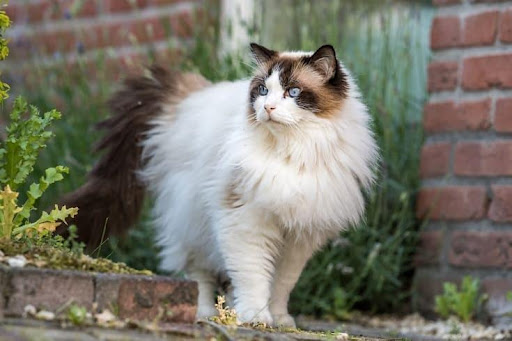The Ragdoll cat is the perfect choice if you’re looking for a large, affectionate being who isn’t afraid to get involved in whatever is going on in your life. This is because when such cats are handled, they just tumble on the ground in ecstasy, giving them the nickname.
Never be frightened by the fact that this breed is one of the largest on the continent. They are big softies, shown by their wide blue eyes and loud, throaty purr, among other characteristics. This floof is well-known for being social, making it an ideal option for families with a lot of activity.
History
In comparison to other breeds, this one is rather fresh. In the 1960s, the Ragdoll cat breed was developed in California. Ann Baker, a cat breeder, set out to develop a gorgeous cat with a caring attitude. Ann began experimenting with domestic medium-haired cats from uncertain origins. Josephine, the breed’s first mother cat, was white.
Baker ultimately produced the very first Ragdoll cats after several generations of breeding. The non-matting hair, big stature, and lively nature of these cats made them popular.
Ragdolls were first registered by the Cat Fanciers Association (CFA) in 1993. They are now the sixth most prevalent breed, according to the CFA. Find out more on this link https://www.thesprucepets.com/ragdoll-cat-breed-profile-4583144.
Care
The Ragdoll has a single smooth coat. It’s supposed to mat less than other medium-haired feline coats, according to some sources. This breed must still be groomed at least twice a week in order to prevent matting from occurring.
Its ears must be cleaned on a constant schedule as well as its mouth. Gently massage its ears’ exterior with several drops of lukewarm ear cleaner after they have been thoroughly cleaned. Keep your feline buddy quiet throughout the procedure, and keep some tasty treats on hand to aid in the comfort of your feline companion. After around 5 minutes, use a cotton ball to wipe anything that has accumulated within your cat’s ears.
Ragdolls require frequent toenail cutting to keep their nails looking their best. When you are doing your furry friend’s pedicure, his or her claws will most likely want to sharpen more than normal, so be sure to provide him or her with some attractive scratching posts!
Additionally, ragdolls are social and energetic cats. They need to be entertained with wand toys as well as other interesting toys on a consistent basis. Instead of just placing toys around for your furry friend, get up and play with your furry friend! All of this will assis your cat in losing weight, reducing boredom-related behavior problems, and strengthening family ties. Click on this page to learn more!
Diet
Consult alongside your veterinarian to develop a diet that is suitable for your Ragdoll’s age as well as the level of activity. Wet meals, in general, contain moisture that can assist avoid urinary problems. Make sure the food is rationed and not left out in the cat’s bowl the whole day.
Every time your pet eats, its insulin increases. Regardless of how good quality the food is, if you notice that your pet is leaving out food, it could mean that it’s struggling with diabetes. Because they spend so much of their energy lying about, using puzzle toys for feeding/playing with them is a fantastic way to keep their lives interesting.
Are they allergy-friendly?
Ragdolls are not hypoallergenic, which is problematic for allergy sufferers. Breeders that say otherwise are just looking for a fast buck! So, do some research in advance.
This breed doesn’t have an undercoat, which can help those who are sensitive to dander have fewer allergic responses. However, most humans are sensitive to cat saliva as well as skin secretions. Ragdolls emit the same allergens that cats do in their saliva as well as skin secretions. Want to know more? If so, make sure to check out holistapet for more helpful details!
What about their health issues?
All breeds are susceptible to genetic health problems, and even mixed-breed pets can develop genetic illnesses. It’s crucial to understand what diseases your chosen type is prone to, so you may ask breeders about the necessary tests. Any breeder who claims that their kittens don’t require health tests or assurances should be avoided.
Ragdolls, like many big breed cats, are likely to be overweight. Keeping your cat fit and trim may be as simple as feeding it puzzle toys as well as portioning out its regular meal. Playing with your cat on a daily basis is also beneficial to his weight control. While “fluffy” obese cats are adorable, they are unhealthy!
There isn’t much genetic variation among purebred Ragdolls. Bladder stones or hypertrophic cardiomyopathy are two conditions that they are susceptible to. Bladder stones are unpleasant and might cause problems with your cat’s litter box. Encourage your cat to drink plenty of fresh water and offer it high-quality food to help your furry friend prevent bladder stones and some other urinary illnesses.
Because hypertrophic cardiomyopathy is hereditary, it is more difficult to avoid. HCM is a heart condition that causes the muscle tissue to thicken. Breeders can use genetic testing to assist them in avoiding mating cats with HCM, but they can never be too sure because there’s always a risk.









